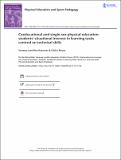Coeducational and single-sex physical education: students’ situational interest in learning tasks centred on technical skills

Type de référence
Date
2019Langue de la référence
AnglaisEntité(s) de recherche
Résumé
Background: A student’s choice to engage in a learning task is highly related to the student’s environmental stimuli and his or her perception of interest. From this perspective, the construct of situational interest (SI) has been used to interpret students’ motivation in task engagement. SI is assumed to be transitory, environmentally activated, and context specific. It has been conceptualized as a multidimensional construct with five dimensions: instant enjoyment, exploration intention, attention demand, novelty, and challenge. Few prior studies have compared SI between girls and boys in physical education (PE) contexts, and these studies have offered contrasting findings. They were conducted in coeducational (coed) or single-sex contexts and used learning tasks centred on a variety of outcomes: technical or tactical skills, creativity and cultural understanding. Purpose: In the context of the debate on single-sex and coed classes in PE, this study aimed to estimate the effects of single-sex and coed PE classes on students’ situational interest (SI) within learning tasks centred on technical skills. The researchers decided to study learning tasks centred on the development of students’ technical skills, since these tasks are often used by teachers in PE. Participants: The sample consisted of 177 Swiss secondary school students, aged 11–17 years (M = 14.07, SD = 1.41, 96 boys, 81 girls). Data collection: The students completed the French 15-item SI Scale after practising a technical learning task in single-sex and coed PE contexts. The researchers chose five physical activities (i.e. athletics, basketball, dance, gymnastics, and volleyball), which are commonly taught in the state of Vaud (Switzerland) and provide a balance between masculine and feminine activities. Data analysis: A two-way repeated-measures MANOVA was performed to examine the main and interaction effects of student sex and class sex composition on the five SI dimensions. Findings: The results showed a main effect of class sex composition on student SI but no main effect of student sex and no interaction effect of student sex and class sex composition. More precisely, the scores for three SI dimensions (i.e. instant enjoyment, exploration intention, and attention demand) were higher in the coed context than in the singlesex context. Conclusions: This study encourages teachers to propose coed PE classes to enhance students’ motivation and engagement when practising learning tasks centred on technical skills. This study offers supplementary evidence of the teacher’s role in promoting student SI.Titre du périodique
Physical Education and Sport PedagogyMaison d’édition
RoutledgePays d'édition
Grande-Bretagnep-ISSN
1740-8989e-ISSN
1742-5786Evaluation par les pairs (peer reviewing)
ouiVolume / tome
24Fascicule
3Pagination
287-300URL permanente ORFEE
http://hdl.handle.net/20.500.12162/3844Autre(s) URL(s) permanente(s)
http://doi.org/10.1080/17408989.2019.1571186Document(s) associé(s) à la référence
Texte intégral :
Fichier
Accès
Commentaire
Version
Taille
- Tout ORFEE
- Détail référence



